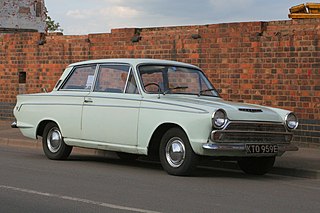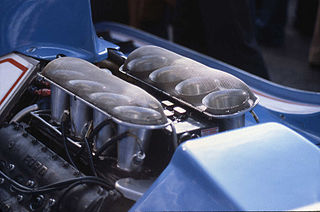Waggott Engineering was an Australian automotive engineering company which gained fame for the engines which it produced for motor sport applications from the 1950s through to the 1970s. The company had its origins in a machine shop opened in 1948 by Merv Waggott. Initially concentrating on commercial refrigerator repairs and general engineering it later diversified into the production of after-market parts for automotive and motor sport applications. This was followed in the mid-1950s by the development and production of the Waggott TC engine. [1] Although based on the six-cylinder Holden “Grey” motor it was extensively modified with twin overhead camshafts, a special crankshaft and three twin choke Weber carburettors. As fitted to the Centaur Waggot in which John French won the 1962 Australian GT Championship, the engine was producing 202 bhp, over three times the 62 bhp output of the standard Holden unit. [2]
John French is an Australian retired racing driver.
The 1962 Australian GT Championship was a CAMS sanctioned motor racing title for drivers of Appendix K GT cars. The title, which was the third Australian GT Championship, was contested over a single race held at the Lakeside circuit, in Queensland, Australia on 8 July 1962.
The Waggott TC4V engine followed in 1968. This was developed from the four-cylinder Ford Cortina engine block [3] with the addition of a new head design featuring twin overhead camshafts and four valves per cylinder. The TC4V saw success in 1600cc form in Australian Formula 2 racing and in 2000cc form in Australian Formula 1. A 1600cc variant with two valves per cylinder was produced to meet new, more restrictive Australian Formula 2 regulations which applied from 1971.

The Ford Cortina is a car that was built by Ford of Britain in various guises from 1962 to 1982, and was the United Kingdom's best-selling car of the 1970s.

Australian Formula 2, sometimes abbreviated to AF2 or ANF2, is a "wings and slicks" formula racing category in Australia. The category is one of Australia's oldest, dating back to 1964. The current format of AF2 was introduced in 1978. Brian Shead of Cheetah Racing Cars and Garrie Cooper of Elfin Racing Cars were largely responsible for the development of the format, which was devised to suit the needs of Australian drivers, most of whom had little or no sponsorship and had to bear the costs of racing out of their own pockets.

Australian Formula 1 (AF1) was a motor sport category for open-wheeler racing cars which was current in Australia from 1970 to 1983.
At this time Waggott Engineering were specialising in camshaft development but also offered automotive “balancing, boring and dyno tuning services”. [4] Although founder Merv Waggott was to die in a plane crash in 1982, the company continued and is now trading as Waggott Cams and headed by Merv’s son Peter. [1]


















